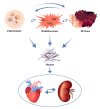Fibrosis, the Bad Actor in Cardiorenal Syndromes: Mechanisms Involved
- PMID: 34359993
- PMCID: PMC8307805
- DOI: 10.3390/cells10071824
Fibrosis, the Bad Actor in Cardiorenal Syndromes: Mechanisms Involved
Abstract
Cardiorenal syndrome is a term that defines the complex bidirectional nature of the interaction between cardiac and renal disease. It is well established that patients with kidney disease have higher incidence of cardiovascular comorbidities and that renal dysfunction is a significant threat to the prognosis of patients with cardiac disease. Fibrosis is a common characteristic of organ injury progression that has been proposed not only as a marker but also as an important driver of the pathophysiology of cardiorenal syndromes. Due to the relevance of fibrosis, its study might give insight into the mechanisms and targets that could potentially be modulated to prevent fibrosis development. The aim of this review was to summarize some of the pathophysiological pathways involved in the fibrotic damage seen in cardiorenal syndromes, such as inflammation, oxidative stress and endoplasmic reticulum stress, which are known to be triggers and mediators of fibrosis.
Keywords: cardiorenal syndrome; endoplasmic reticulum stress; fibrosis; heart failure; inflammation; kidney disease; oxidative stress.
Conflict of interest statement
The authors declare no conflict of interest.
Figures



References
-
- McCullough P.A., Jurkovitz C.T., Pergola P.E., McGill J.B., Brown W.W., Collins A.J., Chen S.-C., Li S., Singh A., Norris K.C., et al. Independent Components of Chronic Kidney Disease as a Cardiovascular Risk State. Arch. Intern. Med. 2007;167:1122–1129. doi: 10.1001/archinte.167.11.1122. - DOI - PubMed
Publication types
MeSH terms
Grants and funding
LinkOut - more resources
Full Text Sources
Research Materials

